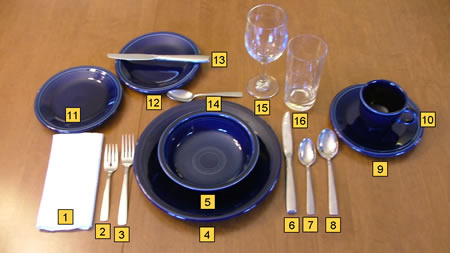Understanding the Formal Place Setting
In formal dining settings, there are many different pieces of silverware and china to use. Knowing which pieces go with which setting is pertinent. With all of the pieces, this can sometimes be a confusing situation.
The following pictures shows a formal place setting. Each piece is numbered, and the names of the pieces are listed below the illustration.
| 1. Napkin | 5. Soup Dish | 9. Saucer | 13. Bread Knife |
| 2. Salad Fork | 6. Dinner Knife | 10. Coffee Cup | 14. Dessert Spoon |
| 3. Dinner Fork | 7. Teaspoon | 11. Salad Plate | 15. Wine Glass |
| 4. Dinner Plate | 5. Soup Dish | 12. Bread Dish | 16. Water Glass |
In the picture, you can see the following basic placements:
- Forks on the left of the dinner plate, while the knife and spoons are on the right
- Salad and bread dishes are found above the dinner plate to the left
- Glasses are found above the dinner plate to the right
The most basic place setting rule is to work your way in. Your dining utensils will be placed in the order you need them starting on the outside and moving in towards the dinner plate. If a certain course is not served, then you would skip using the utensil associated with that course. For example, if salad is not served, but you are given a salad fork. Simply, leave the salad fork on the table.
In this place setting diagram, the napkin is positioned to the left of the forks. This may be the case when you are dining in a formal setting. However, do not be surprised to see the napkin appear in other places in your place setting--such as in a cup.
For extra place setting practice, explore the interactive place setting game.
